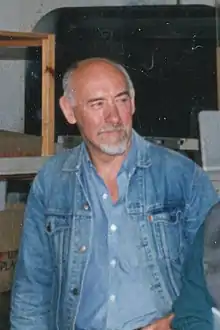Ronald Lewis Vanderwal | |
|---|---|
 Ron Vanderwal at Museum Victoria (Swanston Street, Melbourne), 22 December 1995 | |
| Born | 7 August 1938 |
| Died | 19 July 2021 |
| Nationality | American |
| Citizenship | Australian |
| Scientific career | |
| Fields | Archaeology |
| Institutions | La Trobe University Museum Victoria |
Ron Vanderwal (born 1938)[1] was an American-Australian Archaeologist who specialised in the prehistoric archaeology of the Pacific and New Guinea in particular. He worked at La Trobe University and the Museum of Victoria.[2] He died on 19 July 2021.[3]
Vanderwal studied Anthropology at Michigan State University (BA in 1961) and the University of Wisconsin–Milwaukee (MA in 1969).[1] From 1965 to 1969 he was archeologist in Kingston, Jamaica[4] where he help establish a museum at the Institute of Jamaica. He moved to Australia in the 1970s undertaking a PhD in the prehistory of Papua at the Australian National University and subsequently taking on a role at the Tasmanian Museum.[5] He was the first in 1969 to excavate the Yule Island site of Oposisi where the first millennium AD decorated Early Papuan pottery style horizon was defined.[6]
He taught archaeology and prehistory at La Trobe University in 1978 with David Frankel in Australian coastal archaeology including fieldwork in remote places such as his pioneering work on the Papuan coast into prehistoric pottery, also with Nigel Oram on the history of the material culture exchange system.[7] In 1981 he excavated the artificial mounds in the middle of Kinomere Village on Urama Island in the Papuan Gulf.[8] He also undertook research at the Victoria Archaeological Survey compiling ethnographic records and editing their records.[9]
Vanderwal began work at the Museum of Victoria on 31 August 1981 and was Senior Curator of Anthropology (Oceania) at Melbourne Museum up to his retirement in August 2009.[5] He established the Pacific Islands Advisory Group to include Islanders in the development of the museum exhibitions. In 2009 he received the Award for International Relations by the Australian branch of the International Council of Museums in recognition of his twenty years of work promoting the cultural rights of Pacific Islanders in collaboration with the Fiji Museum.[5]
References
- 1 2 Foreword to Vanderwal and David Horton's Costal Southwest Tasmani
- ↑ David Frankel, Carving a gope board The Artefact 2010 - Volume 33, Southern New Guinea & Torres Strait Edited by Ian J. McNiven & Mike Green, Special issue in honour of Ron Vanderwal pp. 49 - 55
- ↑ "Dr Ron Lewis Vanderwal". The Age. Melbourne, Victoria, Australia. 22 July 2021. Retrieved 27 August 2021.
- ↑ The Oxford Handbook of Caribbean Archaeology William F. Keegan, Corinne L. Hofman, Reniel Rodriguez Ramos Oxford University Press, USA, 7 Feb 2013 p251
- 1 2 3 Museum Victoria "A chance to catch up" 28 August, 2009
- ↑ Jim Allen,1 Glenn Summerhayes, Herman Mandui & Matthew Leavesley, Journal of Pacific Archaeology – Vol. 2 No. 1 2011, New Data from Oposisi: Implications for the Early Papuan Pottery Phase
- ↑ Oram, N. 1982. Pots for sago. The hiri trading network. In T. Dutton (ed.) The Hiri in History. Further Aspects of Long- Distrnce Motu Trade in Central Papua, pp. 1–34. Pacific Research Monographs 8. Canberra: Australian National University;Vanderwal, R.L. 1973. Prehistoric Studies in Central Coastal Papua. Unpublished PhD thesis. Canberra: Australian National University; Vanderwal, R.L. 1984. Kinomere Village: Papua sixty years after Hurley. Conference of Museum Anthropologists 14: 21-25.
- ↑ Frankel, D., K. Thompson and R.L. Vanderwal 1994. Kerema and Kinomere. In D. Frankel and J.W. Rhoads (eds), Archaeology of a Coastal Exchange System: Sites and Ceramics in the Gulf of Papua, pp. 1-50. Research Papers in Archaeology and Natural History 25. Canberra: Australian National University
- ↑ Vanderwal, Ronald L.; Records of the Victoria Archaeological Survey. Number 8, November 1978 / honorary editor: R. Vanderwal. 1978; Aboriginal Victoria - History - To 1834, Victorian Aborigines : John Bulmer's recollections 1855-1908 / compiled by Alastair Campbell ; edited by Ron Vanderwal